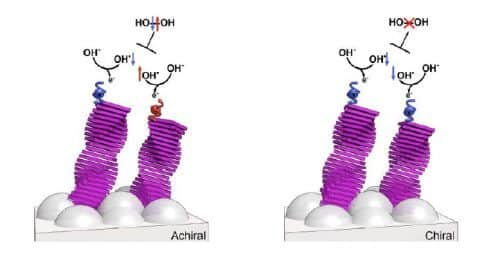How can hydrogen be produced by separating it from water, without the byproduct of the process appearing - hydrogen peroxide? Scientists from the Weizmann Institute and their partners recently succeeded in inhibiting the production of hydrogen peroxide, by controlling the spin (spin attack) of the electrons participating in the reaction.

Hydrogen, the most common element in the universe, may be used as an efficient, renewable and environmentally friendly fuel. Burning it does not pollute the air. But attempts to produce hydrogen by separating it from water (composed of oxygen and hydrogen) encountered an obstacle in the form of the byproduct of the process - hydrogen peroxide ("hydrogen peroxide"), which affects both the efficiency of the reaction and the stability of the process. Scientists from the Weizmann Institute of Science and the University of Technology in Eindhoven, the Netherlands, recently succeeded in greatly inhibiting the production of hydrogen peroxide, by controlling the spin (spin attack) of the electrons participating in the reaction. their findings Were published in the scientific journal Journal of American Chemical Society.
Many scientists strive to develop a way to break down water into its components, using the sun's energy, which will be absorbed in photo-electrochemical (solar) cells. However, until now the efficiency of the process of breaking down the water in this way has been relatively low, and to this is added the unwanted byproduct, hydrogen peroxide, which causes corrosion in some of the electrical contacts in the system, which further reduces the efficiency of the process.
This is where they came into the picture Prof. Ron Naaman from the Department of Chemical Physics at the Weizmann Institute of Science and his research partner, Prof. Bert Meier from the University of Technology in Eindhoven, the Netherlands. They focused on the role played by the spin property (spin attack) of the electrons participating in the chemical reaction of the decomposition of water and the separation of hydrogen. Their premise was that if it was possible to coordinate two electron spins on both sides of the process, then the formation of hydrogen peroxide would be avoided. This is because the ground (quantum) state of hydrogen peroxide requires two electrons with spins in opposite directions; Oxygen, on the other hand, is formed when the spins of its electrons are aligned in the same direction.
The secret to the success of the study was color. The scientists coated one of the electrodes in the photoelectrochemical cell (a titanium dioxide anode) with an organic dye containing chiral supramolecular structures (that is, structures that cannot be overlapped with their mirror image). These unique structures allowed scientists to inject into the chemical reaction only electrons with spin in a certain direction. This work was based on the findings of a previous study in Prof. Naaman's laboratory, in which he showed that the transfer of electrons through chiral molecules is selective, and depends on the spins of the electrons. That is, such molecules may serve as a kind of "filters" that pass through them electrons whose spins are oriented in a certain direction. "When we activated the spin filter on the water decomposition process," says Prof. Naaman. "The formation of hydrogen peroxide was almost completely inhibited. And beyond that, the current in the cell increased to a great extent." Since there are many chiral molecules in nature, the scientists anticipate that this finding will have great significance in many fields of research.
"It is still too early to say how this finding may improve the production efficiency of hydrogen fuel," says Prof. Meyer. "At this point, we intend to continue the basic research designed to deepen understanding and optimize the process."
#Science_Numbers
Electron spin control improves hydrogen production efficiency by 50%.
